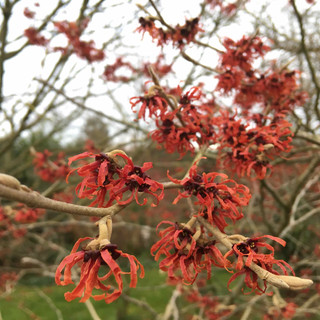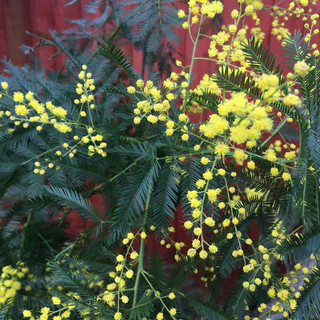
February is one of the most important months on the gardening calendar. Why? One word - pruning! It is the last chance to get essential pruning jobs complete.
Many plants are dormant so it is an ideal time to prune them before the sap starts rising and buds burst into action. All pruning requires sharp secateurs or lopers. Make clean cuts roughly 5 mm above an outward facing bud that slope away from the bud, this helps avoid rot from sitting rain water.
Climbing, rambling, hybrid tea, floribunda and shrub roses can all be pruned now. Establish what rose(s) you have and prune to specific guide lines of that cultivar. General advice, reduce stems by third to a half; this stimulates new flowering growth. Cut out any dead stems or dieback to fresh wood, this should encourage new growth. If a plant performed poorly last year, be brave, prune hard to renovate; roses are tough and bounce back, a fresh, more compact version of its former self.

Prune Wisteria. Reduce shoots pruned last July/August to two to three buds. This concentrates the energy on generating short spurs for this year's flower display and restricts excessive foliage growth.

Prune winter-flowering shrubs that have finished flowering such as Jasminum nudiflorum winter flowering Jasmine.
Summer flowering Clematis (Group three) can be pruned now as they flower on this season's growth so prune hard to around 30cm from the base and new growth will soon appear.

Prune apple and pear trees whilst they are dormant (prune from November till early March). Winter pruning ultimately stimulates new growth but it also improves ventilation, light and shape. Look at your tree and select damaged, diseased or dead material to remove, any visable pests and reduce tree height.
Buddleja davidii and Sambucus (elderflower) respond well to being pruned hard. They are both vigorous growers and soon restore their stems. The hard prune ensures a good display of fresh summer flowers.

Not everything in the winter garden is dormant in February.
By complete contrast February also brings some amazing gifts in the shape of Galanthus nivalis snowdrops and Hamamelis (mollis and x intermedia) witch hazel:
Crocus start popping up through lawns and borders and Helleborus uncurl their magnificent petals and humbling hang their heads in glorious technicolour:
Coronilla valentina subsp. glauca 'Citrina', Mahonia japonia x media 'Charity', Acacia dealbata Mimosa are all shining like sun beams this time of year and have been for most of winter. Good plants for longevity of flowering period:
Wafts of exquisite scent are emitted from Virburnum x bodnantense:

Skimmia japonica 'Rubella' (m) and 'Nymans (f) planted together ensure bright red berries on the female shrub and an effortless relentless flowering period over winter in shady borders:
Camellia japonica, petite Iris reticulata 'Harmony' and Vinca major 'Alba' are all radiantly blooming with sumptuous whites and rich blue hues.
Daphne bholua 'Jacqueline Postill' is in its prime January/February. Daphne is a slow growing evergreen shrub which exudes intoxicating scent. An absolute must if space allows.

Chaenomeles speciosa Japanese quince flowers on bare stems and is a wonderfully colourful edition to brighten up walled areas at this time of year.

Chimonanthus praecox Winter Sweet is pretty non-descript for most of the year but January/February you discover why it is such an asset in the garden. A wealth of dainty bell-like drooping heads of enticingly scented flowers cover bare woody stems.

Aconites and Garrya elliptica 'James Roof' whose colour respectively brings the garden out of hibernation and suggests the hope of approaching season.

February is also a great month for a spring clean before the garden leaps into action. Tidy beds, finally cut back spent perennials such as Perovskia, deadhead and generally maintain plant health to ensure they make it through the final chapter of winter. Remove rotten or mouldy material.
If the weather is not of arctic temperatures then wash the greenhouse windows inside and out. Ensure everything is cleaned down, zapping over wintering pest and diseases. Sparkling windows will let in every drop of light.
Look under pots, old bags of compost and general nooks and piles of materials. Slugs and snails will probably have set up home so remove them before they become active. Run your 'gloved' hand under the rim of garden containers, this is a classic spot for elusive critters.
Weed thoroughly to deter perennials taking over and annuals going to seed. Clearing weeds now will help prevent them taking hold later.
Be careful not disturb soil unnecessarily whilst weeding as this will bring dormant seed to the surface and create the next generation of weeds!
Mulch bare soil from now to March to keep weeds down and to try and suppress weed seed germinating. Well rotten horse manure is ideal to add nutrients and improve soil structure.
Check over-wintering dahlias for rot or dried shrivelled tubers. If sand has dried out, lightly mist with water but do not soak. Can be potted on end of the month and new shoots will sprout. Photo shows the tuber prepped before it was embalmed in moist sand. (Ensure all soil, worms and bugs were washed off tuber when placed in a lined container ready for a covering of damp sand).

When snowdrops have finished flowering they can be divided.
Cut back grasses to approximately 30cm if not already done so before new growth appears. If you have Stipa grasses then hand pull rather than cut.
We all get a bit twitchy this time of year and the desire to sow seeds is difficult to resist. Start your season off with sowing chillies. The chilli crazy really seems to have crescendoed this year! Easy to grow and so many varieties to choose from; the colours and strengths in heat can become a collector's paradise.
If possible try and buy organic seed, particularly if you are an organic gardener as this ensures your entire gardening process from start to finish can then be pesticide-free.
This year I am growing seven different varieties: Early Jalapeneo, Hot Cayennette, Cherry Bomb, Purple Serrano, Numex Twilight, Hungarian Hot Wax and Orange Wonder. Look forward to having a 'hot' summer!
Enjoy all the planning, prepping and colourful, scented delights of the February garden.
Spring is just a round the corner...










































